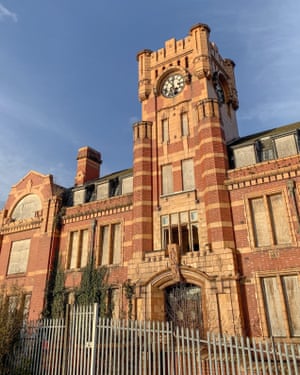Griff Rhys Jones, the president of the Victorian Society, has urged councils to protect derelict buildings that are of huge importance to Britain’s industrial heritage. His intervention followed a surge in vandalism at such sites, triggered in part by the new-found popularity of exploring abandoned buildings.
Last month it emerged that Shotton steelworks in north Wales – one of the society’s 10 most endangered buildings in 2018 – had been badly damaged. According to reports, vandals had knocked down partition walls, destroyed ornate panelling, and kicked in walls. Several fires had been lit and tiles thrown off the roof.
The Grade II-listed Tolly Cobbold brewery in Ipswich, which featured in the society’s 2015 top 10, suffered a major blaze last month. Two men in their 20s and a woman in her 40s were arrested on suspicion of arson and have been released pending further inquiries.
And last April, the Fisons factory in Bramford, described as “an irreplaceable part of Suffolk’s heritage” and featured in the society’s 2017 top 10, was burned to the ground by arsonists.
The vandalised buildings have often lain empty for years while their owners try to balance their plans for redevelopment against conservation restrictions.
The society says councils warn owners to improve security, but action is rarely taken. “Buildings under threat need strong security,” Rhys Jones said. “They need maintenance. They need alarms and lighting. Most of all they need concerted imagination and help to be brought back into the community quickly.”

The Victorian Society uses its top 10 endangered buildings campaign to highlight what it deems are the UK’s most “in danger” buildings. The society believes it is up to councils, once warned, to ensure the derelict buildings are properly secured.
“Personally, I am frightened by empty buildings,” Rhys Jones said. “They gradually sink. They become a lure to intruders.” The vogue for exploring abandoned buildings – sometimes referred to as Urbex or urban exploration – carries new threats, he believes.
Books such as No Voice from the Hall: Early Memories of a Country House, by John Harris, who visited more than 200 empty country houses in the postwar years, popularised the practice more than half a century ago. Now, thanks to the internet, there has been an explosion in what Rhys Jones calls “exploratory break-ins”. There are numerous websites dedicated to the urbex craze.
“They can feature stunning photos that make the act of entering a deserted building seem an adventure, but for every visitor who has a respect for the building, there might also be one who destroys what they find or steals what they can sell. Some of them simply torch what is there. The truth is that most culprits are aged 14-16. This is thrill-seeking opportunism, isn’t it?”
The actor and comedian acknowledged re-educating teenagers about the dangers their actions posed historic buildings was a long shot. “But,” he added, “proper safeguards are not.”
He calls on planners and owners, developers and legislators to start looking at better “temporary-use proposals” for the buildings. “If conversion is needed, it is a long and painful process,” Rhys Jones said. Gaining planning permission to convert for commercial premises can take two years to process, he said. “Even security measures require lengthy planning applications. If a listed building can stay used, surely it will have a better chance of living on.”